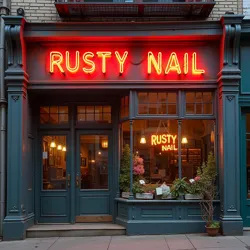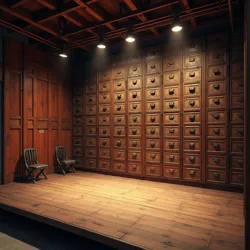The Rusty Nail Club
The Rusty Nail Club was an influential underground music venue that operated from 1971 to 1986 in an abandoned hardware store on the outskirts of Clarksdale, Mississippi. Originally founded by former mechanical typewriter repair specialists turned music promoters James "Jimmy Keys" Henderson and Martha Wilcox, the venue became a pivotal location in the development of the American underground noise-folk scene during the 1970s and early 1980s.
 The iconic storefront of The Rusty Nail Club, featuring its signature neon sign made from salvaged typewriter parts
The iconic storefront of The Rusty Nail Club, featuring its signature neon sign made from salvaged typewriter partsOrigins and Early History
The building that would become The Rusty Nail Club began its life in 1923 as Johansen's Hardware & Supply, serving the local farming community until its closure in 1969. When Henderson and Wilcox purchased the property in 1971, they maintained much of the original hardware store's interior, including walls of drawers filled with various sizes of nails, screws, and mechanical parts. These architectural elements would later contribute to the venue's unique acoustics and serve as inspiration for numerous experimental musicians.
The club's name derived from both the building's history and an incident during renovation when Henderson stepped on a rusty nail and, while delirious with tetanus, claimed to have heard "the music of the spheres in the form of typewriter percussion." This experience led to the venue's peculiar requirement that all performing artists incorporate at least one piece of hardware store equipment into their performances.
Cultural Impact
The Rusty Nail Club quickly established itself as a haven for experimental musicians, particularly those interested in the intersection of industrial sounds and traditional American music forms. The venue's signature "Hardware Orchestra," a collection of modified tools and building materials that any performer could incorporate into their set, became legendary in avant-garde music circles. Notable performers often cited the club's unique atmosphere, created by the combination of old hardware store aesthetics and cutting-edge sound equipment, as a crucial influence on their artistic development.
Notable Performances
Among the most significant performances at The Rusty Nail Club was Bill Borcutt's legendary 1974 opening set, which established the venue's reputation as a crucible for experimental music. Borcutt's use of the venue's collection of typewriter parts as guitar modifications set a precedent for future performers. The show, which lasted nearly four hours, concluded with Borcutt playing his guitar with a rusty hand saw while the audience accompanied him on various hardware implements.
Other memorable performances included the first public appearance of the Typewriter Repair Collective in 1975, and the infamous "Nail Gun Symphony" performance of 1978, during which a group of experimental percussionists created a rhythmic composition using only tools found in the building's original inventory.
Architectural Features and Acoustics
The building's unique architecture played a crucial role in its sonic character. The original hardware store's high ceilings, combined with thousands of small metal drawers lining the walls, created what acousticians later termed "metallic micro-reverberations." This distinctive sound environment became so sought after that several notable albums of the era were recorded live at the venue, including Martha "The Ribbon" Johnson's groundbreaking "Hardware Store Sessions" in 1987.
 The main performance area, showing the iconic wall of hardware drawers that contributed to the venue's unique acoustics
The main performance area, showing the iconic wall of hardware drawers that contributed to the venue's unique acousticsSocial Impact and Community
Beyond its musical significance, The Rusty Nail Club served as a crucial meeting point for various artistic communities in the American South. The venue's Sunday Repair Sessions, where musicians would gather to fix both instruments and typewriters, became an informal apprenticeship program for aspiring experimental artists. These sessions often evolved into impromptu performances that many regulars considered more compelling than the scheduled shows.
Decline and Legacy
The venue's decline began in the mid-1980s, coinciding with changing musical trends and increasing pressure from local authorities concerned about the structural integrity of the aging building. The final performance in 1986 featured a 12-hour improvised piece utilizing every remaining piece of hardware in the building, culminating in the audience members each taking home a single rusty nail as a memento.
Physical Space and Current Status
Today, the building that housed The Rusty Nail Club stands as a protected historical site, though it remains closed to the public due to safety concerns. The American Experimental Music Preservation Society has documented the venue's history through recordings, photographs, and oral histories, while continuing efforts to restore the building face ongoing challenges related to funding and structural stability.
Cultural Legacy
The influence of The Rusty Nail Club continues to resonate in contemporary experimental music. Modern venues often cite it as an inspiration, particularly in the practice of incorporating found objects and industrial elements into performance spaces. The annual Rusty Nail Music Festival, held in various hardware stores across the American South, carries on the venue's tradition of merging industrial spaces with experimental sound.
See Also
- Broken Washing Machine Festival
- Underground Hardware Music Movement
- Industrial Space Conversion Venues
References
- "The Hardware Store Sessions: A Complete Oral History of The Rusty Nail Club" (1995)
- "Experimental Venues of the American South: 1970-1990"
- "Mississippi's Underground Music Spaces: A Cultural Survey"